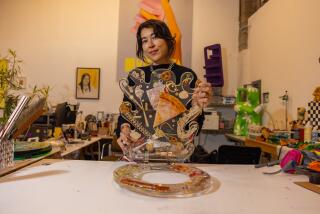Tools With a Twist Bloom on the Table
- Share via
Eating used to be a lot more fun back in the days when we were all walking semi-upright and learning to play with fire. The process was pretty simple: You went out and clobbered a mastodon, got the neighbors to help you drag it home, cut it up and threw everything in the fire. Then you got to eat it with your hands and fling the bones over your shoulder.
That was great fun.
Then tools came along and spoiled it all. No sooner was the knife invented than folks began to see it as a more genteel way to ram food into their craws. And, in spite of the fact that this use resulted in the accidental widening of more than one mouth, the knife was de rigueur for centuries. It only began to fall out of favor when an English king, so the legend goes, bisected a royal lip while eating peas. The slightly less lethal fork arrived soon after.
Finally, in spite of the fact that forks made terrific rhythm instruments, spoons appeared and eliminated forever one of the more enjoyable acts of basic dining: slurping soup straight from the bowl.
So now man was mannerly. But who could have expected the vast thicket of baffling dedicated-use items that the fashionable epicure would demand? In the Victorian era, when 14-course meals became a popular hobby, one might have been confounded by a mustache spoon or an oyster fork or, amazingly, an ice cream saw. You saw fewer tools on a surgery table.
The folks at Tiffany & Co. claim that we moderns have managed to pare the list back a bit, but who could tell by taking inventory of their new “American Garden” line of flatware and china?
The pattern, Tiffany says, is the latest and most complex flatware design of this century, and the porcelain that goes with it is pretty spectacular, too (no simple gold pin stripes here; these plates blaze off the tablecloth with borders of poppies, roses and forget-me-nots).
But Tiffany seems most proud of the new silver and, what with the sheer volume of flatware available, there’s a lot to be proud of.
There are no fewer than 27 different table tools available in the “American Garden” line, and they have a characteristic that is sure to confuse the butler if he’s been getting into the cooking sherry: Each piece displays a different botanical pattern on the handle.
You’re certain to recognize a few old and familiar friends on the following list, but press on. By the time you get to the end of this, you’ll not only feel too full for lunch, you’ll never eat with plastic utensils again. Here’s the more familiar part of the line, with corresponding patterns:
- Teaspoon (wild rose)
- Luncheon fork (dogwood blossom)
- Luncheon knife (orange blossom)
- Dessert spoon (tomato flower)
- Butter spreader (wheat)
- Dinner fork (poppy)
- Dinner knife (potato flower)
- Salad fork (dandelion)
- Cream soup spoon (pea)
- Tablespoon (magnolia)
- Cake knife (honeysuckle)
- Sauce ladle (currants)
Now for the exotic stuff:
- Coffee spoon (forget-me-not)
- Cold meat fork (Indian corn)
- Serving fork (buttercup)
- Gravy ladle (clover)
- Cake server (pineapple)
- Iced tea spoon (mint)
- Hollow-handled butter spreader (apple)
- Fish fork (water iris)
- Fish knife (waterlily)
- Afternoon teaspoon (chamomile)
- Cheese server (grape)
- Cocktail fork (jalapeno pepper)
- Vegetable spoon (squash blossom)
- Roast carving fork (Texas bluebonnet)
- Roast carving knife (Texas sunflower)
Ready for still more variety? Although each of the flatware pieces displays a single plant design, the design on one side of the handle is different from the one on the other side. That makes a total of 54 separate designs if you buy the entire line of “American Garden” flatware.
Of course, you don’t have to buy it all. Your motivation might flag a bit when you learn that a single five-piece place setting of the china costs nearly $325 and a single place setting of the dinner silver runs almost $500. Start adding such burglar’s tools as the fish knife and fish fork to each setting and the cost graph starts to ascend.
Still, said Jo Ellen Qualls, the vice president of Tiffany & Co. at South Coast Plaza, “the interest in it has been far greater than I anticipated. It seems to appeal to an awful lot of different tastes. It might surpass our Audubon pattern, which has been our best-selling pattern for 100 years.”
Part of the appeal, she said, might have to do with the uniqueness of the pieces as you twirl them in your hand. Making flatware molds with a different design on each side, said Qualls, had never been tried before.
Now if Black & Decker would only revive the idea of the ice cream saw . . .
More to Read
Eat your way across L.A.
Get our weekly Tasting Notes newsletter for reviews, news and more.
You may occasionally receive promotional content from the Los Angeles Times.










